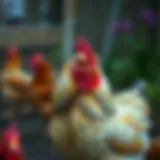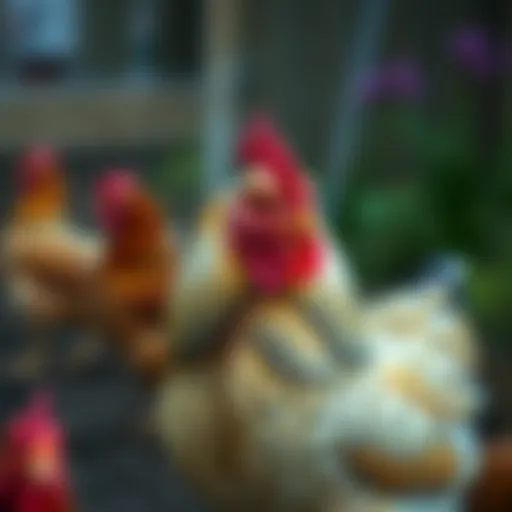Exploring the Meal Worm Diet: A Unique Approach to Nutrition
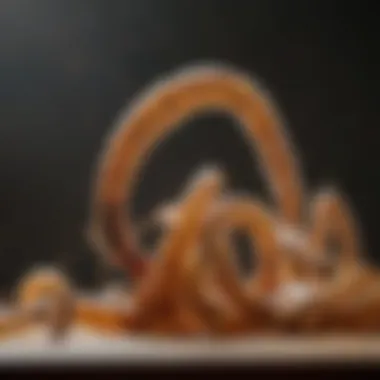

Intro
The conversation about diet often steers clear of unconventional options, like the meal worm diet. Recently, though, this subject has created waves in the nutrition sphere. Meal worms, often perceived as pests, are being examined for their nutritional value and adaptable use in diverse dietary contexts. While some may raise an eyebrow at the thought of consuming or utilizing these critters, there’s more to the meal worm than meets the eye.
An intriguing combination of protein, healthy fats, and essential vitamins makes meal worms a noteworthy contender amongst traditional food sources. This article aims to unveil the richness of meal worms when it comes to nutritional value, their ethical aspects, how they can play a role in pet nutrition, and a comparison with other options available in the market. Given its relevance in today’s eco-conscious climate, understanding the implications of adopting this unique dietary choice is of utmost importance.
Allowing room for a careful analysis will help pet owners and nutritionists alike to engage with the meal worm diet, considering its benefits and potential drawbacks. Each element contributes to building a clearer picture of how incorporating meal worms can influence overall wellbeing.
Understanding the Meal Worm Diet
Grasping the ins and outs of the meal worm diet plays a pivotal role in understanding its place in modern nutrition. The conversation around alternative protein sources has become more relevant than ever, particularly as the world looks for sustainable solutions to various health concerns. By delving into the meal worm diet, we can uncover the potential benefits and considerations that could shape future dietary habits.
Definition and Origin
Meal worms, or Tenebrio molitor, are the larval form of the darkling beetle. These creatures have a history steeped in culinary tradition, particularly in some Asian and African countries. Initially, they were employed largely as animal feed, but now they are being recognized for their nutritional prowess for human consumption. The concept of edible insects isn’t new, having been part of various cultures' diets for centuries. It’s only recently that the Western world has started to take notice of their potential.
Nutritional Composition
Understanding the nutritional composition of meal worms is crucial to comprehending their role in a balanced diet. They offer a generous array of nutrients that can complement traditional food sources.
Protein Content
One of the standout features of meal worms is their protein content. A robust aspect of their nutritional profile, these insects pack a wallop with about 50-60% protein by dry weight. This makes them an attractive option for those looking to increase their dietary protein without hefty environmental costs. The amino acid profile of meal worms is also noteworthy; they contain all the essential amino acids, which is a rarity among many plant sources. This makes meal worms a beneficial choice for vegetarians and flexitarians seeking alternative protein. However, some might find the idea of consuming insects unsettling, although the benefits are hard to ignore.
Fatty Acids
When examining the fatty acids in meal worms, it becomes evident that they can contribute positive effects to overall health. These little critters are about 20-30% fat, primarily composed of unsaturated fatty acids. Omega-3 and Omega-6 fatty acids, in particular, are crucial for heart health and overall wellbeing. They are essentially good fats that our bodies require. This unique feature makes meal worms an appealing option for those wanting to balance fat intake without resorting to traditional sources like red meat, which can raise concerns about cholesterol levels. However, it's essential to consume them in moderation to avoid excess caloric intake.
Vitamins and Minerals
The vitamin and mineral content of meal worms further sets them apart in the nutritional landscape. Packed with essential vitamins like B vitamins—thiamine, riboflavin, and B12—they support energy production and contribute to a healthy metabolism. Additionally, the presence of minerals such as iron, calcium, and zinc makes these larvae valuable not just for protein but for their broader nutritional benefits as well. Their unique advantage lies in the ease of digestion they offer, rendering them beneficial for all ages, including growing children who need robust nutrition. Like any ingredient, balance is key. Over-reliance on any single food source can lead to nutrient imbalances.
In summary, understanding the meal worm diet involves recognizing its potential as a viable nutritional source. The combination of their high protein content, beneficial fatty acids, and rich array of vitamins and minerals presents a compelling case for incorporating these insects into various dietary patterns.
Health Benefits of Meal Worms
The modern-day quest for nutritious solutions has taken many paths, but none as novel and promising as the meal worm diet. This section peels back the layers on how meal worms pack a powerful punch in the nutritional department. Not only do they provide an outstanding source of sustenance, but they also offer a robust alternative to conventional sources of protein. Understanding these benefits is crucial for those exploring ways to elevate their dietary practices, whether for personal health or as part of pet nutrition.
High Protein Source
Meal worms are hailed as a powerhouse of protein, offering about 50-70% of their dry weight as protein. To put that in perspective, compare it to beef, which contains around 26% protein content. This makes meal worms an exceptional candidate for anyone looking to boost their protein intake without a staggering environmental impact.
Moreover, the protein present in meal worms is of high biological value. This means the body can efficiently use this protein for muscle repair and growth, critical for active individuals and pets alike. Incorporating meal worms into one's diet can support muscle maintenance and overall physical health.
"In a world where traditional protein sources are under scrutiny, meal worms emerge as a sustainable alternative that not only nourishes but also aligns with eco-friendly objectives."
Digestibility Factors
Meal worms are not just packed with protein; they also boast an impressive digestibility rate. Studies suggest that the digestion rate for meal worms can exceed 80%. What does that mean for you? Simply put, it means that the majority of nutrients get absorbed by the body, reducing waste and enhancing overall nutrient utilization.
This highly digestible nature also benefits pets who may have sensitive stomachs. Unlike some traditional proteins that can sit heavy in a pet's stomach or lead to digestive upset, meal worms can be much easier on their systems. Adding these to pet food formulations could promote better gut health and absorption of essential nutrients.
Nutritional Superiority Compared to Traditional Foods
When weighing the merits of meal worms against conventional protein sources, the differences become strikingly clear. In addition to their high protein and digestibility, meal worms contain a unique profile of fatty acids like omega-3 and omega-6, which are pivotal for maintaining heart health and reducing inflammation.
Other benefits include:
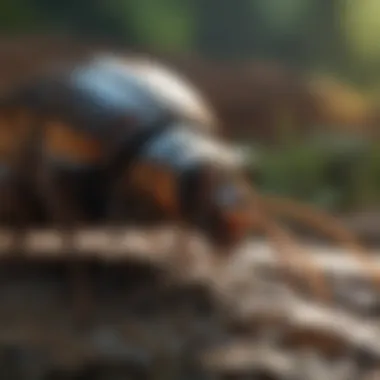

- Vitamins and Minerals: Meal worms are rich in B vitamins, particularly B12, which is crucial for energy production and neurological health. They also provide essential minerals like calcium, iron, and zinc.
- Lower Environmental Footprint: They require significantly less land and water compared to beef production, making them an environmentally savvy choice.
- Versatility: Meal worms are exceptionally versatile and can be easily incorporated into various dishes, from soups to snacks, catering to diverse culinary preferences.
Incorporating Meal Worms Into Your Diet
Integrating meal worms into your daily meals can provide both nutritional enhancements as well as broaden your culinary horizons. This section delves into how incorporating these versatile larvae can be beneficial in various forms, focusing on preparation methods and delicious recipes. Adopting a meal worm diet not only introduces new flavors but also offers a sustainable source of nutrition that can complement any dietary regimen.
Preparation Methods
Roasting
Roasting is a particularly popular method for preparing meal worms, as it transforms their texture and flavor profile into something quite delightful. When exposed to heat, the meal worms become crunchy and can develop a nutty taste that appeals to many. Roasting is also simple; it requires minimal prep, just a bit of seasoning — perhaps some salt or spices for flavor. This method is beneficial for those who enjoy a crisp snack and is ideal for adding a protein punch to salads or as toppings on dishes. However, care must be taken not to over-roast them, as they can become too dry or lose essential nutrients.
Baking
Baking meal worms is another way to incorporate them into a diet while keeping their nutritional benefits intact. In this method, the worms can be included in baked goods like muffins, cookies, or even incorporated into bread recipes. The key characteristic of baking is that it allows for the blending of meal worms with other ingredients, masking their distinctive textures while still providing all the health benefits. The unique feature of baking involves creating delicious treats that are appealing to both adults and kids alike. One downside can be the challenge of promoting these baked goods to those hesitant about eating insects, as the visual aspect may put off some.
Powder Form
Using meal worms in powder form is a game changer. Ground-up meal worms can be added to smoothies, soups, or even protein bars. This method keeps the ingredients simple while still providing a substantial protein boost. The powdered version is also versatile; it can easily be mixed into various foods without changing the flavor significantly. The uniqueness of using powder is its ease of incorporation and the opportunity to add nutrients without much fuss. However, some may find the idea of consuming food containing insect powder off-putting at first, but it’s worth trying for added health benefits.
Meal Worm Recipes
Snacks
Snacking on meal worms is an innovative way to enjoy them without having to get too fancy. Roasted meal worms make for an excellent on-the-go snack, packed with protein and great crunch. They can be seasoned with various flavors, from chili powder to garlic, allowing for creative snacking options. The appeal lies in their high protein content, which provides energy while being low in carbs, making it an ideal choice for health-conscious individuals. However, some who are new to this snack may find the idea of eating insects daunting, which can be a barrier.
Smoothies
Incorporating meal worms into smoothies is a wonderful option for those looking to boost nutrition without sacrificing taste. Blending them in with fruits, vegetables, and other ingredients can mask their presence while providing a protein-rich drink. This method is beneficial because it allows for an easily digestible source of nutrients that can fit seamlessly into the busy routine of many. A downside might be the need to ensure the worms are blended finely enough to avoid any grainy texture that could be unappealing.
In Pet Food
Meal worms are increasingly finding their way into pet food formulations, owing to their high protein content and ease of digestibility. Many pets, including dogs and cats, can benefit from the addition of meal worms as part of their diet. The unique feature here is that pet food manufacturers are discovering that meal worms can contribute to a more sustainable protein source for our furry friends, which can be both nutritionally superior and eco-friendly. However, like any new ingredient, owners should introduce it gradually to see how their pets react.
Incorporating meal worms into various forms of our diet allows for creativity in the kitchen and a responsible choice for protein sources.
Ethical Considerations
Exploring the meal worm diet doesn’t just stop at its nutritional benefits; it opens the door to a more profound dialogue about ethics and sustainability in food production. As the world grapples with the ever-increasing demand for protein and the environmental impact of traditional livestock farming, meal worm farming presents a more sustainable alternative. This section delves into why ethical considerations matter, particularly in the context of sustainability and food security.
Sustainability of Meal Worm Farming
Meal worms are not just another source of food; they offer an unprecedented breakthrough in sustainable farming practices. Unlike cattle or chickens, meal worms require significantly less land and water, making them a more feasible option for producing protein. For instance, to raise 1 kilogram of beef, approximately 15,000 liters of water are needed, while only 3,000 liters are necessary for the same amount of meal worms. This stark difference highlights a key benefit of meal worm farming: resource efficiency.
Additionally, meal worms can be raised on organic waste. In fact, they thrive on decomposing materials like fruit and vegetable scraps, which not only reduces waste but also lowers the carbon footprint associated with food production. Raising meal worms closer to urban centers can help further minimize the environmental impact by decreasing transportation emissions.
"Meal worms exemplify a circular economy approach—a system that uses resources more wisely while also addressing waste."
Food Security Implications
Food security is of paramount importance in today's world. With the global population projected to reach over nine billion by 2050, there is a pressing need to reevaluate our food sources. Meal worms could be part of the solution. They proliferate rapidly, allowing for higher yields in shorter time frames compared to traditional livestock. In fact, meal worms can be harvested in just a few weeks, as opposed to months or years for larger animals.
Moreover, incorporating meal worms into diets can play a significant role in diversifying food sources, particularly in regions facing food scarcity. By promoting meal worms, communities can foster resilience against food shortages, ensuring broader access to protein-rich foods.
As awareness and acceptance grow among pet owners and animal lovers, integrating meal worms into diets can improve food options not only for pets but also for humans.
In a nutshell, ethical considerations surrounding the meal worm diet underscore the importance of sustainability and security in our food systems. It invites a critical examination of how we produce, consume, and value nutrition in an evolving world.
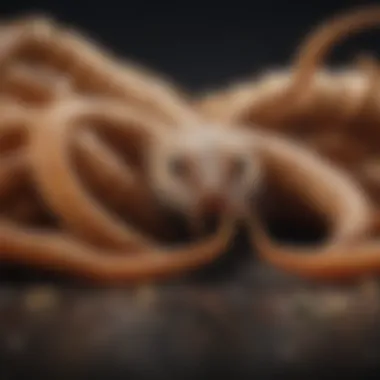

Meal Worms and Pet Nutrition
The inclusion of meal worms in pet nutrition is a concept that's gaining traction for good reason. As households become more conscious of sustainable eating, the benefits of meal worms extend to our furry friends and little critters. Pets, much like humans, have specific nutritional needs which have to be met to ensure their wellbeing. Understanding these needs is crucial.
Nutritional Needs of Pets
Pets require a balanced diet, consisting of proteins, fats, vitamins, and minerals. For dogs and cats, the spotlight often shines on proteins, as these building blocks are essential for muscle development and overall health. In particular, protein sourced from insects, like meal worms, offers a remarkable alternative to conventional meat sources. The amino acids in meal worms can bolster muscle growth and repair, making them a notable player in the pet nutrition arena.
When it comes to small animals, such as hamsters and gerbils, they also benefit from high-protein diets. Meal worms can provide these little creatures with a healthy source of protein, contributing to their energy levels and supporting their active lifestyles. They also contain healthy fats, which are important for maintaining shiny coats and healthy skin.
Incorporating Meal Worms into Pet Diets
Fitting meal worms into your pets' diets isn't as daunting as it may sound. Here’s how you can serve up these creepy crawlies effectively:
Benefits for Dogs
For canines, the inclusion of meal worms can enhance their diet significantly. As a protein source, they are considered easily digestible, which means your dog can absorb nutrients without much energy expenditure. This makes meal worms an attractive choice, especially for pets with sensitive stomachs. Additionally, many dog owners have noted how the unique texture of dried meal worms can even entice picky eaters. However, care should be taken to introduce them gradually, as any change in diet requires a thoughtful approach.
Benefits for Cats
Cats, being obligate carnivores, thrive on protein-rich diets. Meal worms can complement the traditional meat options available. For an easy-to-digest protein option, meal worms fit the bill beautifully. They can also bring variety to a cat's diet, which could stimulate their appetite. Moreover, the omega fatty acids found in meal worms support healthy fur and skin. It's wise, though, to monitor their reaction when meal worms are introduced, as some felines may need time to adjust completely.
Small Animals
For smaller pets, like guinea pigs or rabbits, meal worms can be a beneficial addition, too. Not only do they deliver vital proteins, but they are also small enough to be easily consumed. What sets meal worms apart is their high fat content, which is essential for energy production in these active little creatures. However, moderation is key; excessive protein or fat can lead to health issues. As with all dietary changes, it's a good rule of thumb to proceed with caution and consult a vet if unsure.
"Insect-based proteins like those from meal worms could be the future of pet nutrition—sustainable, nutritious, and versatile."
By skillfully integrating meal worms into your pets' diets, you open up a new world of nutrition that's both beneficial and exciting.
Challenges and Concerns
As we delve into the meal worm diet, it's essential to recognize the challenges and concerns associated with it. While the potential benefits of meal worms are numerous, a balanced evaluation cannot overlook specific issues that might affect consumers and pet owners alike. Understanding these challenges is crucial for making informed decisions about incorporating meal worms into dietary routines and considering them for animal nutrition. Below, we examine two pivotal concerns regarding allergic reactions and regulatory aspects.
Allergic Reactions
When considering meal worms as part of a diet, one cannot dismiss the possibility of allergic reactions. Individuals who have allergies to shellfish may find themselves at risk since meal worms, a type of insect, contain similar proteins. These proteins can trigger reactions in susceptible people, potentially leading to symptoms such as rashes, swelling, or even more severe responses.
The myth that allergies to insects are rare does not hold up universally. A study noted that around 2% of the population might be affected, making it challenging to pinpoint who could react negatively. Therefore, it's wise for anyone looking to introduce meal worms into their diet to approach with caution. Here are some considerations:
- Start Slow: Introducing meal worms gradually into one’s diet can help monitor any adverse reactions.
- Consult with Professionals: Discussing dietary changes with healthcare providers can provide clarity on risks.
- Read Labels: Knowing where meal worms come from and their preparation process can also impact allergy risks.
In the realm of pet nutrition, pet owners should remain alert to similar allergy possibilities in their pets. Certain breeds might be more sensitive to new protein sources, and observing any unusual behavior or symptoms after introducing meal worms is vital.
"Awareness of possible allergies is a step toward safe dietary exploration when it comes to meal worms. One must tread carefully to ensure the health of both humans and pets."
Regulatory Aspects
The regulatory landscape surrounding meal worms can be somewhat murky, and it is an area worth noting for anyone contemplating this dietary path. As insect consumption becomes more mainstream, various countries are establishing frameworks to govern the production and sale of edible insects, but those regulations often differ widely.
In the United States, for instance, the FDA has yet to classify meal worms under the same guidelines that apply to traditional livestock and poultry. While meal worms are considered generally safe to eat, there are no strict regulations regarding their farming, processing, or distribution. This lack of oversight raises questions about the quality and safety of commercially available meal worms. Here are some key points to consider:
- Source Verification: It’s essential to purchase meal worms from reputable suppliers who adhere to established safety standards.
- Labeling Guidelines: Understanding product labels can aid in ensuring you're getting quality meal worms.
- Global Variations: What’s accepted in one country may not be held to the same standard elsewhere, so consumers should be aware when sourcing products internationally.
As the conversation around edible insects grows, regulatory bodies may adapt to include more comprehensive guidelines in the future. Staying informed and proactive is beneficial not only for consumers but also for the ethical considerations of animal welfare and food security that come with insect farming.
Comparative Analysis
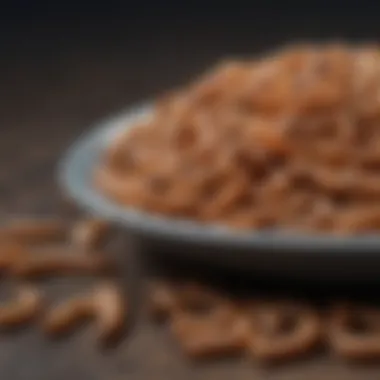

Comparative analysis plays a vital role in understanding the meal worm diet in relation to other dietary options. It offers insight into how meal worms stack up against various insect sources as well as traditional protein. This analysis is crucial for pet owners and enthusiasts looking to enhance their pets’ nutrition or their own dietary choices. By comparing nutritional profiles, environmental impacts, and digestibility, individuals can make informed decisions that align with their health and nutrition objectives.
Meal Worms vs. Other Insects
When we take a good look at meal worms alongside other insects, we find that they often stand out in certain key areas. Meal worms are the larval stage of the darkling beetle, and their gentle taste profile can be particularly appealing for both human consumption and pet food. Some common alternatives include crickets, grasshoppers, and silkworms.
Here are some aspects to consider:
- Nutritional Value: Meal worms contain a balanced profile of protein, fat, and vital vitamins. Compared to crickets, they might have a higher fat content. Crickets, on the other hand, can provide higher levels of omega-3 fatty acids but less vitamin B12.
- Taste and Texture: Meal worms tend to have a mild flavor and softer texture, making them easy to incorporate into various dishes, unlike some other insects which can have a more pronounced taste that not everyone might fancy.
- Availability and Cultivation: Meal worms are relatively easier to farm in comparison to many other insect varieties. They require less space and can thrive on a variety of organic waste substrates. This makes them a go-to for sustainable farming practices.
- Digestibility: Often, meal worms are more digestible for pets, especially smaller animals. They provide nutrients efficiently without causing significant digestive strain, which can sometimes happen with harder-shelled insects like crickets.
"In the quest for sustainable protein sources, the role of Meal Worms surpasses many traditional insect options in flavor, ease of preparation, and nutritional density."
Meal Worms vs. Conventional Protein Sources
When comparing meal worms to well-established protein sources like chicken, beef, and fish, the clear advantages start to emerge. While these conventional sources have been staples in diets for ages, they come with their own drawbacks.
- Environmental Sustainability: Meal worms require significantly less land, water, and feed compared to traditional livestock. Raising meal worms generates fewer greenhouse gases than cattle farming, making them an eco-friendlier option.
- Nutritional Content: While chicken is high in protein, meal worms come surprisingly close while also offering essential fatty acids and unique vitamins. A 100-gram serving of meal worms can pack in about 20-25 grams of protein, not far behind chicken's 25-30 grams.
- Cost-Effectiveness: Depending on the region and availability, meal worms can often be cheaper to rear than conventional livestock. The startup costs of insect farming are typically lower. With rising meat prices, meal worms may provide a budget-friendly alternative.
- Health Considerations: Unlike some conventional meats, meal worms are less likely to carry pathogens if properly raised. They are also gluten-free, making them suitable for people with celiac disease or gluten sensitivity.
This comparative lens creates a more comprehensive view of meal worms as a viable dietary source, not only for pets but for humans alike. The shift towards sustainable, nutritious options is clear, and meal worms present a promising alternative that may very well surprise the skeptics.
Future of the Meal Worm Diet
The meal worm diet represents a paradigm shift in our approach to nutrition. With global population steadily on the rise, it’s essential to explore innovative food sources that not only provide ample nutrition but also mitigate environmental strain. The role of meal worms is becoming increasingly significant in this context, acting as a sustainable and nutrient-rich option. This section delves into the various facets that indicate a promising future for incorporating meal worms into diets, focusing on both culinary trends and scientific advancements.
Trends in Insect Consumption
The soil has been tilled for quite some time now, with insects like meal worms steadily working their way into the mainstream. Aided by rising awareness about sustainability and the environmental burdens caused by traditional livestock farming, many are now seeking alternatives that are aligned with their values. It’s not just about eating bugs for the thrill; it's a movement driven by necessity.
- Increased Acceptance: Across various cultures, particularly in regions where insects are already a staple source of nutrition, there’s a burgeoning acceptance of meal worms as an everyday food item. This cultural shift is critical in addressing food scarcity issues worldwide.
- Health-Conscious Dieting: With health trends steering towards clean eating and organic sources, meal worms shine due to their high protein content and low carbon footprint. Individuals are more inclined to try these options and supplement their diets with integrated protein sources that fit their fitness regimes.
- Innovative Products: Food startups are flooding the market with creative items infused with meal worm protein, from high-protein bars to eco-friendly protein shakes. This trend not only caters to health enthusiasts but also tempts a broader audience who are beginning to view meal worms as a viable and delicious protein source.
This acceptance can be likened to the increasing popularity of plant-based diets, where individuals previously uninterested in alternative proteins are now actively exploring all options available. The stage is set for meal worms to become a mainstay on store shelves.
Research and Development
Innovation doesn’t stop at the dinner table; ongoing research is laying the groundwork for the meal worm diet’s future. Scientists are meticulously examining how to optimize meal worm farming practices and nutritional profiling. Their insights could shape the next wave of food production in the coming decades.
- Nutritional Enhancements: Researchers are investigating ways to enhance the nutritional composition of meal worms through dietary modification, which increases the levels of beneficial fatty acids and micronutrients. These efforts aim to yield meal worms that not only provide basic sustenance but are also fortified with essential minerals and vitamins.
- Sustainability Studies: Ongoing studies in sustainable farming techniques underscore the minimal resource requirements necessary for raising meal worms. Compared to traditional meat production methods, the water and feed conversion ratios are significantly lower, presenting a compelling case for widespread adoption.
- Consumer Safety: Scientists are also focused on ensuring that the consumption of meal worms aligns with health and safety standards. As the popularity of this diet expands, robust research into potential allergenic reactions and best farming practices is essential.
In summary, the buzz around meal worms isn't a fleeting trend but rather the start of an evolutive journey towards a sustainable future. As culinary trends lean towards health-conscious options and as scientific research continues to support these nutritional enhancements, meal worms could very well occupy a significant portion of our diet in the years to come. Their role in combatting food insecurity while catering to health trends embodies the heart of innovative eating practices in the modern age.
"Sustainability doesn’t have to be difficult; it can simply be delicious."
This journey towards integrating meal worms into our diets aligns with broader conversations about the future of food security, environmental health, and our collective responsibility in nurturing the planet.
Culmination
The conclusion of this article centers around the multifaceted benefits and unique considerations of incorporating meal worms into various dietary practices. The meal worm diet stands out, not only for its rich nutritional profile but also for its sustainability and potential to address pressing global food security issues. By examining the various aspects of meal worms—from their rich protein and nutrient content to their role in pet diets—this article highlights how such an unconventional source of nutrition can indeed enhance the well-being of both humans and pets.
Summary of Key Points
In navigating through the complexities of meal worm consumption, we have highlighted several pivotal points:
- Nutritional Superiority: Meal worms are packed with protein, vitamins, and minerals, often surpassing conventional sources in terms of digestibility and nutrient density.
- Sustainability: Their farming requires significantly less land, water, and feed compared to traditional livestock, making them an eco-friendly alternative.
- Pet Nutrition: Pets benefit from the health-rich profiles of meal worms, which can be tailored into their diets, offering new avenues for pet owners to enrich their pets’ meals.
- Ethical Aspects: The rise in meal worm farming resonates with the ethical considerations of sustainable food sourcing, posing less impact on the environment.
These key points illustrate the meal worm diet's potential not simply as a nutritional option but as a pivotal step toward a more sustainable and ethical approach to food production.
Final Thoughts
As we wrap up this exploration into the meal worm diet, it’s essential to view it not merely as a trend but as a significant development in our food landscape. The increasing shift towards insect consumption is steadily gaining traction across the globe, driven by both necessity and innovation. The prospects for meal worms extend beyond just an alternative protein source; they represent a broader movement towards sustainability and ethical consideration in food choices.
However, as with any dietary transition, it is vital for individuals—especially pet owners—to conduct thorough research and consider personal and animal tolerances. If you’re intrigued or even skeptical about integrating meal worms into your diet or that of your furry friends, this article contains the groundwork for making informed decisions.
Embracing the meal worm diet can be a step towards rethinking not only our nutrition but also our relationship with the planet. Armed with knowledge, there lies an opportunity to make conscientious choices towards a healthier and more sustainable future.






